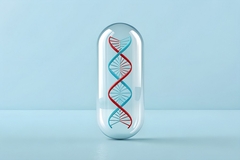Wine’s “dark matter”: UC Davis creates multi-omics framework to unlock gut impacts

Wine has long been studied for its cardioprotective effects and some findings link its moderate consumption to an impact on gut microbiome diversity and function. However, researchers from the University of California (UC) Davis, US, point to significant research gaps in interactions between wine’s compounds and those in food, even though wine is “nearly universally paired with food.”
They review how to leverage advances in multi-omics technologies to characterize wine’s “dark matter,” and consider how interactions between wine components and food matrices impact gut health. Multi-omics combines data from biological molecules of one specific type, such as carbs or proteins.
Nutrition Insight meets with two of the review’s authors to discuss how multi-omics and AI can enhance understanding of how moderate wine consumption influences health, especially when combined with food, and the importance of nuanced scientific research.
“The paper addresses an important principle in nutrition — one cannot focus on the health effects of a single factor contained in a given food or beverage, but rather the food matrix made up of thousands of compounds should be taken into account,” says Sean Adams, Ph.D., professor and vice chair for Basic Research at UC Davis’ School of Medicine.
Justin Siegel, professor of Chemistry, Biochemistry, and Molecular Medicine at UC Davis and faculty director at the university’s Innovation Institute for Food and Health, details that nutrition science has traditionally isolated single ingredients or molecules to conclude on food and health impact.
“But real-world diets are far more complex. This review challenges that reductionist mindset. It calls for a new era of nutrition science that embraces complexity, context, and co-consumption.”
“Thanks to advances in multi-omics and AI, we now have the tools to systematically analyze the interactions between foods, beverages, the microbiome, and the host.”
He hopes the research helps accelerate the shift toward a precision nutrition paradigm that is data-driven, mechanistic, and capable of informing the design of foods and dietary patterns that optimize health outcomes at scale.
Wine-food-gut axis
Because wine is often consumed with foods, Adams says that the factors that make up wine, including ethanol, may influence how people process foods and how the gut microbiome metabolizes food components.
“These interactions have not been studied much, but could be important to understanding how bioactive factors in food are made available to the body.”
 Mass spectrometry is the main tool researchers use in multi-omics, to analyze components in food and nutrition.Siegel highlights that despite wine’s cultural and culinary significance and common pairing with food, no comprehensive scientific study has ever explored how these combinations influence the gut microbiome and health.
Mass spectrometry is the main tool researchers use in multi-omics, to analyze components in food and nutrition.Siegel highlights that despite wine’s cultural and culinary significance and common pairing with food, no comprehensive scientific study has ever explored how these combinations influence the gut microbiome and health.
“What we see in the literature is the power of both wine and food to shape gut health in meaningful ways,” he adds. “But the magic may lie in the synergy. Just as a meal is more than the sum of its parts, the combination of wine and food may unlock effects on gut health that we’re only beginning to imagine. That’s the frontier — and it’s wide open for exploration.”
The authors note that these findings reinforce the need for a “systems-level, mechanistic approach” to dietary science.
“Rather than relying on population averages or broad generalizations, precision nutrition aims to understand how specific dietary components interact with the biology of the gut — microbial and human alike,” says Siegel.
He adds that tools like multi-omics can move research “beyond correlations and toward causality,” helping quantify the biochemical transformations that occur when wine and food are consumed together, and to model their downstream effects on health. “This is the kind of insight needed to inform the next generation of food innovation, clinical guidelines, and public health strategies.”
The power of multi-omics
The review paper, published in Advances in Nutrition, explores various multi-omics technologies, such as glycomics to characterize carbohydrates, lipidomics for fats, and proteomics for proteins.
Adams says modern omics technologies allow molecular-level insights. “To understand the mechanisms that underlie the health effects of foods and beverages, it’s important to consider the myriad factors that make up their compositions. This is a major challenge to catalog the thousands of factors.”
“Importantly, it’s not just what’s in the wine or combination of wine and food that matters. The microbes in the gut serve as a powerful bioreactor that can transform what we eat and drink into new compounds that can impact health.”
 Siegel highlights the importance of embracing the complexity of the wine-food-gut axis and using the right tools to analyze it.Siegel adds that multi-omics tools offer a systems-level approach to determine how thousands of compounds work together, are transformed by the gut microbiome, and how they ripple through a person’s biology.
Siegel highlights the importance of embracing the complexity of the wine-food-gut axis and using the right tools to analyze it.Siegel adds that multi-omics tools offer a systems-level approach to determine how thousands of compounds work together, are transformed by the gut microbiome, and how they ripple through a person’s biology.
“And it brings us closer to answering the big, exciting questions: How can food heal? How can it be tailored to the individual? And how can we use that knowledge to design a healthier future?”
Combining multi-omics with AI
According to Siegel, the intersection of multi-omics and AI offers the most promising research advances along the wine-food-gut axis. “For the first time, we can generate large-scale, interoperable datasets that capture the full molecular complexity of food, wine, the microbiome, and host responses.”
He explains that these datasets are of a scale and dimensionality that far exceed the capacity of traditional correlative methods. “But with modern AI — particularly models designed to handle complex, nonlinear, and multiscale systems — we can begin to uncover relationships once thought too intricate to resolve.”
“This is the key to unlocking the wine-food-gut axis: not by simplifying it, but by embracing its complexity and using the right tools to make sense of it.”
Adams adds that scientists continue to find ways to sample different parts of the gastrointestinal tract. As such, they will be able to determine changes in how the body metabolizes wine and accompanying foods throughout the gut.
“This can lead to profound discoveries related to gut health, digestion, and biotransformation of wine-associated compounds by the natural gut microbe communities.”
Importance of nuanced science
Earlier this year, a meta-analysis concluded there was “no clear evidence” of wine’s protective quality, whereby red wine’s high content of the antioxidant resveratrol is said to help fortify against cancer.
 Adams cautions that focusing on a specific diet component without considering the complex matrix of what is consumed is not ideal.However, Adams stresses that wine contains thousands of compounds in addition to alcohol, many of which are considered to promote health. Therefore, determining the health impacts of moderate wine consumption must consider this matrix.
Adams cautions that focusing on a specific diet component without considering the complex matrix of what is consumed is not ideal.However, Adams stresses that wine contains thousands of compounds in addition to alcohol, many of which are considered to promote health. Therefore, determining the health impacts of moderate wine consumption must consider this matrix.
The researcher says that many epidemiological studies have focused on correlating alcohol intake to health outcomes, but have not considered the specific sources of alcohol (i.e., wine, spirits, beer). “We have learned from several examples in nutrition research that focusing on a specific diet component without considering the complex matrix of what is consumed is not ideal.”
“For instance, for years there was concern about egg consumption due to their cholesterol content, or consuming full-fat dairy due to saturated fat,” details Adams. “Yet, these foods have been shown to have neutral to beneficial health effects and can be a rich source of high-quality protein.”
Siegel stresses that scientific nuance is essential to determine the pros and cons of wine consumption. Excess alcohol consumption, especially, has well-documented health risks. However, wine’s bioactive compound mixture varies between grape varieties, fermentation processes, and pairing contexts, which interact with the gut microbiome when consumed with food.
“Our goal is not to promote wine, but to advocate for research that reflects real-world consumption patterns and the molecular complexity of dietary exposures,” he adds. “Overly simplistic public health messaging — whether about fat, eggs, or processed foods — has historically led to unintended consequences.”
Siegel concludes: “Precision nutrition calls for moving beyond blanket recommendations to evidence-based insights grounded in molecular data. With advances in AI and multi-omics, we now have the tools to do exactly that.”












